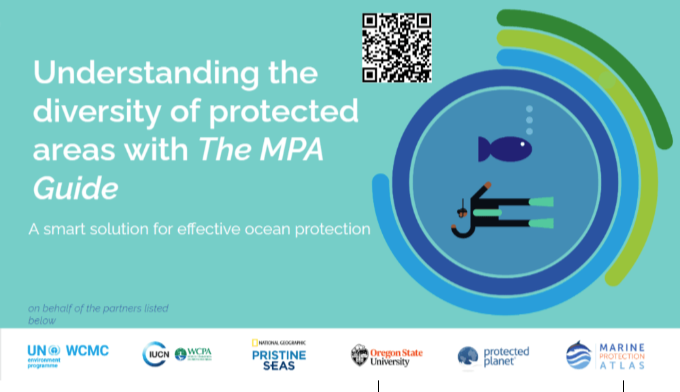
On June 20 2024, a webinar was hosted on the diversity of protected areas with the MPA guide. The event shared insights of the experts who contributed to the MPA Guide and the scientific structure that helps evaluate the outcome of different MPAs.
The development of the MPA Guide was lead by a global expert network, including UNEP-WCMC, IUCN, Marine Conservation Institute, National Geographic Pristine Seas, and Oregon State University, among other expert contributors.
The webinar, moderated by the MedPAN Policy Manager, Carole Martinez, was conducted by many well-known speakers, including Samanta Makovac—Senior Advisor in Nature Conservation, Strunjan Landscape Park; Charles Loiseau—Researcher at the CNRS; Zafer Kizilkaya—President of the Mediterranean Conservation Society; and Paolo Guidetti—Research Director at the Stazione Zoologica Anton Dohrn.
Experience from the Field
The webinar mainly focused on tireless efforts by MPA managers and rangers from the Mediterranean to specific areas in Gökova, Turkey, and Strunjan, Slovenia. Strategies range from patrols, education, public awareness, stakeholder participation, to advanced technologies like drones to safeguard marine biodiversity. The threat is still present despite these efforts, with increased economic pressures and the rise in food prices as manifested in threats like illegal fishing. Zafer Kizilkaya highlighted the ongoing challenges, stating, "We're just trying to protect it every day, day and night."
Curbing the Threat of Bottom Trawling
The MPA Guide views bottom trawling as a grave danger to Mediterranean MPAs, highly destructive to fishery habitats, and recommends a 50% reduction of the bottom trawl effort by 2030. In order to convey the sense of urgency, a BBC report narrated by Sir David Attenborough will air in May 2025 on the disastrous effects of such practice. "Bottom trawling is the principal threat for all MPAs in the Mediterranean. We need to reduce it by 50% by 2030." said Kizilkaya.
Impact of Climate Change and Invasive Species
Rising sea temperatures allow for the increase and proliferation of invasive species, such as rabbitfish, and many local ecosystems have been severely affected. The MPA Guide suggests new measures to tackle these invasive species, such as buying them from the fishermen as an act of economic incentives to control their populations. "We have lost entire undersea forests. We are talking about a huge ecosystem collapse ", notes Kizilkaya, emphasizing on the severity of the situation. Such species can only be managed with the establishment of solid scientific approaches such as tagging lionfish to monitor their behavior.
The Crucial Role of Fully Protected Areas
Fully protected areas within MPAs play an important role in the conservation of local biodiversity and dealing with invasive species. The results of monitoring have shown that the amount of invasive species is significantly smaller in these areas compared to open areas due to strict protection and management. "In fully protected areas there are 15% less invasive species than in unprotected areas," Kizilkaya emphasized, promoting the extension of these protected zones.
Community and Stakeholder Engagement
The MPA Guide placed strong emphasis on community and stakeholder involvement in MPA management. Successful examples in Turkey have come in the form of collaboration among fishermen, local municipalities and maritime administrations. "We have been able to listen to each other over the past ten years and assess their needs and adaptation to the park regime." said Samanta Makovac, highlighting the value of community engagement.
Legal Structures and Regional Approaches
Emna Ben-Lamina, a postdoctoral researcher at the Université de la Côte d'Azur, raised the issue of the effectiveness of MPAs without legal designation. Paolo Guidetti replied, "The law is linked to a country's cultural roots, but any other alternative tool for proposing and imposing rules for managing resources and biodiversity can also work," Here, the need for flexible approaches in different regions is indicated.
Translating Policy into Practice
Edoardo Chiaro Pellegrino emphasized the importance of translating international objectives into effective MPA management. "The legal framework is essential to provide the framework and specify the type of regulatory status, the level of protection and the way of doing, of implementing marine conservation objectives," Carole Martinez added, highlighting the importance of strong management and political support to achieve conservation goals.
The MPA Guide provides a frame of action that includes species-specific ecological challenges of the Mediterranean, like overfishing, bottom trawling, and alien species. What is needed now is immediate action, be it by way of creating new fully protected areas, reducing destructive forms of fishing, or involving sea people on-site in conservation. "TThe more fully protected areas we have, the better we can protect our local biodiversity," concluded Kizilkaya, clearly illustrating the critical need for coordinated local action.
Find out more here.
